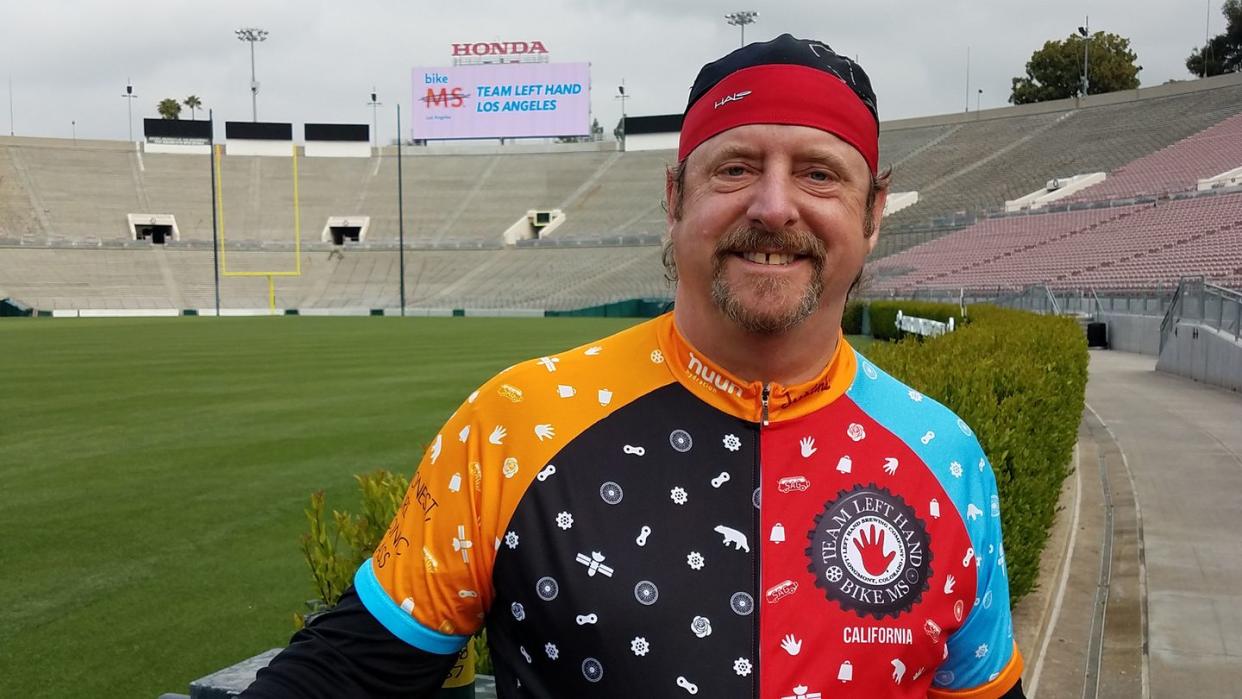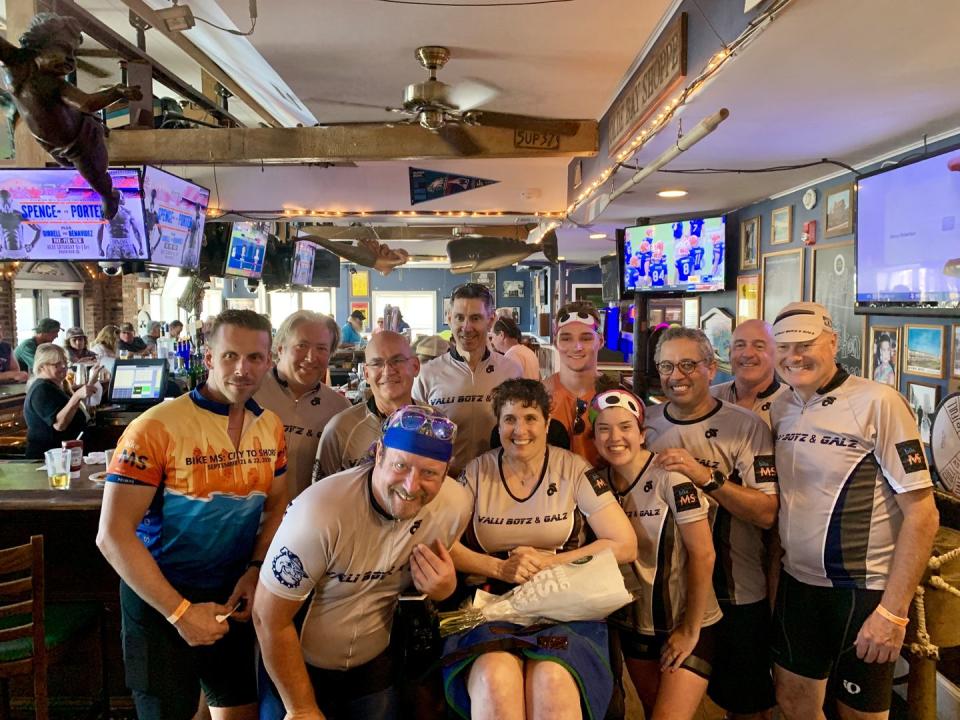A Smoker for Almost 30 Years, He Quit So He Could Conquer Multi-Day Cycling Events

"Hearst Magazines and Yahoo may earn commission or revenue on some items through these links."
Name: Phil Geyer
Age: 64
Hometown: Loudon, Tennessee
Occupation: Retired, previously a director at Praxair, Inc.
Time Riding: 20 years
Reason For Riding: To exercise, stay healthy, and raise money for charitable causes.
Like most, I rode bikes as a kid, but I started to take the sport seriously about 20 years ago.
It was 2005, and I had just moved to the Chicago area for work. One of my coworkers approached me in the outside designated smoking area. She said the company was forming a cycling team to raise money for multiple sclerosis (MS) and anyone who signed up that week would get a free team jersey and a pair of cycling shorts. We’d ride as a team in a two-day event and at the end of each day there would be free beer and entertainment. It sounded like a fun time to me! My 15-year-old, 10-speed Schwinn had more moving stickers on it than miles, but I was in.
After she left, a coworker smoking next to me said he would have asked a few more questions, like what the distance is each day. I was so excited about the beer and the band that such things didn’t even cross my mind. But I went to find her. She said I could ride either 35, 75, or 100 the first day, and 35 or 75 the second day. “Miles?” I asked. “Miles,” she confirmed. Although I said that wasn’t a problem, I also wasn’t doing much exercise at that time, so all these distances sounded long.
On the way home that day, I stopped at Walmart to get a bike rack for my car—I knew I had to start training right away. With three months to go, I had some work to do.
I set a goal of riding five miles a week the first two weeks, 10 miles the next two weeks, 15 miles the following two weeks, and 20 miles for the remaining time before the event. Since I wasn’t cycling at that point, I didn’t own any cycling gear, so I rode my first month of training in T-shirts and gym shorts. As time progressed, I got myself a jersey and biking shorts, and once I experienced the comfort of these shorts, I was visiting my local bike shop regularly.
The minimum fundraising requirement for the event was $300, and I had never done any fundraising. My team members suggested that I send messages to family, friends, and coworkers, and tell them about the event. I started by emailing 20 prospective donors—and raised $500 in a matter of hours. Some donors even had a personal connection to MS. I was truly amazed by people’s generosity and wondered if I could raise more. I sent another 20 emails that day, another 20 the following week, and by the time of the event, I raised more than $2,500, becoming one of the top fundraisers on the team.
The weekend of the ride in June, I was extremely nervous—I had not ridden more than 22 miles at one time, and now was committed to riding 35 miles each day. Having done most of my training by myself, I was a little intimidated when more than 300 riders showed up at the starting line.
About 50 riders were let out at a time and because I was riding the shortest route, I stayed toward the back of the group. I stopped at the rest areas every 10 miles, retrieved my pack of Marlboros from my seat bag, and took a smoke break. Needless to say, I was getting several looks from other riders, but I didn’t mind. It was a beautiful day for a ride, and I felt pretty good the whole time. I finished in two and a half hours.
Though I wasn’t sure whether I wanted to keep riding right away, a week later, I got an itch to get back in the saddle. But first, I treated myself to a new 20-speed Specialized Sequoia. On that bike, I continued increasing my daily distances and my annual miles. By my third year of riding with my work team, I worked my way up to the longest distances: the 100-mile route on the first day and the 75-mile route on the second day.
I continued smoking at first—I had smoked regularly for almost 30 years and never really thought about quitting—but about five years into cycling, I wanted to increase my speed on longer and hillier routes. It was as good a reason as any to quit smoking, so I made it my New Year’s Resolution for 2011.
In the end, I ran out of cigarettes when in Hawaii in December 2010 where cigarettes were very expensive and that was it: I quit cold turkey. It was tough for the first three weeks, but that was about it, and I never looked back. Did I get any faster? Hell no, I gained 25 pounds when I quit smoking, but my doctor said that it was better to carry the extra weight than to keep smoking, so that’s what I did.
Meanwhile, as our Chicago area Bike MS team continued to grow, we started participating in Bike MS rides in other states. As a result, I reconnected with a former Georgetown classmate, Valli Baldassano, who was on the board of the MS Society in the Philadelphia area back then, but also living with MS. Thanks to her, I learned a lot about MS firsthand.
Valli inspired me and another former classmate to form a team, the Valli Boyz, and in September 2010, we rode our first team ride, the Bike MS: City to Shore Event (we have been doing so since).
I met with her the night before the ride in 2010, and you wouldn’t have known she was living with MS. The next year, she was limping, the year after she had a cane, the following year she had to ride on a scooter, and today she’s in a mechanized wheelchair, paralyzed from the chest down, with only the use of one arm.
I’ve met many people with MS over the past 20 years and despite the impact it has on their lives, it’s amazing that they keep such a positive attitude. To me, that’s the most inspiring part of it all and I’ll keep riding until they find a cure.
About 10 years ago, I retired to Loudon, Tennessee. Cycling in Tennessee is much more panoramic than in Chicago. And there is one other big difference: hills! It took about three months to adjust my pace and effort to the hilly riding.
With my riding group, we visit the Great Smoky Mountains to ride the Cades Cove loop. This scenic 11-mile loop is one of the most traveled car roads in the Smokies, but from April to September, Wednesdays are car-free. It’s just us, riders, horses, turkeys, deer, birds, and bears.
Looking back, I’m very thankful that for the last 20 years, I’ve been able to fundraise for nonprofit organizations like Bike MS. The experience is very fulfilling and the impact is evident when I talk with those who are living with MS, volunteer, and ride in these events. I get to experience the joy of cycling and contribute to a great cause without feeling like I’m exercising.

These three tips have made my riding journey a success:
1. Keep track of your mileage
It’s amazing how numbers can help motivate you to do just one more ride that month to get over a threshold or set a new personal record.
2. Ride in any safe conditions
If you only ride when it’s sunny and warm, with no wind, you won’t be prepared for riding in a scheduled event with unpredictable conditions. You want to practice clothing selection, food and drink choices, and everything else.
3. Don’t sweat fundraising minimums
Create a large potential donor list of family, friends, coworkers, and neighbors, and don’t deny anyone the opportunity to support a cause. People will donate because they have a personal connection to the cause or simply because it’s important to you.
Phil’s Must-Have Gear
→ Specialized Turbo Connect Display (TCD): It’s important to have a bike computer to track your distance, cadence, and pace to ensure you are not overexerting yourself and can finish the ride back to your car.
→ Rockbros Waterproof Top Tube Bag: This is a great place to store and easily access your phone, car keys, wallet, and snacks while you’re riding.
→ Sponeed Men’s Bicycle Pants: Fleece tights for colder weather conditions breathe a lot better than waterproof pants and the fleece will keep you warm even when wet (like a wet suit). In case the rain stops or it gets warmer, most tights have zip areas at the bottom of the legs that will allow you to take them off without removing your cycling shoes.
We want to hear how cycling changed you! Send your story and submit your photos to us via this web form. We’ll pick one each week to highlight on the site.
You Might Also Like

